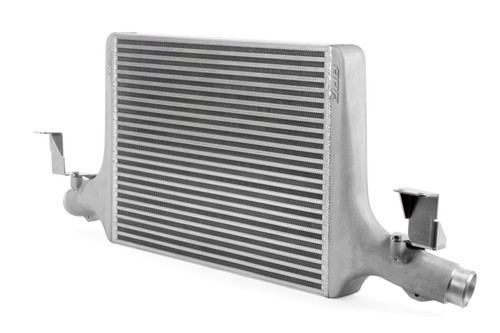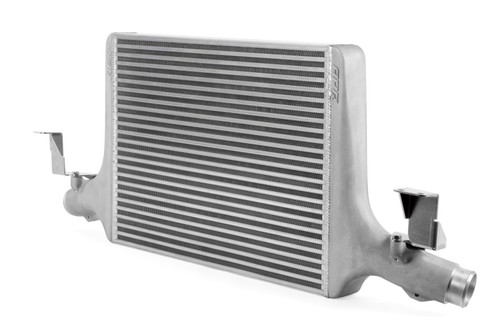Overview
Fits 2011-2017 Audi Q5
Features:
- Dramatically lowers intake air temp (IAT)
- Increases horsepower while minimizing power-robbing heat soak!
- 17 horsepower gain over the factory system!
- Massive frontal surface area and core volume
- 2.50" x 5.50" x 26.00" - 143.0 in² front. & 357.5 in³ volume - OEM
- 2.25" x 16.2" x 22.00" - 356.4 in² front. & 801.9 in³ volume - APR
- Highly effective core design
- Bar-and-plate core with staggered and louvered fins.
- Rigorous testing determined core style, fin density, and size
- Low pressure drop + highly effective cooling = high performance!
- Smooth cast end tanks
- Engineered for low turbulence/restriction and maximum flow.
- Organically shaped to promote airflow across entire core.
- Pressure tested to prevent power robbing boost leaks.
- Easy to install
- With the bumper removed, install takes minutes!
- No trimming or drilling necessary!
- Full directions and APR world-renowned customer support included
- Designed by engineers with lasers
- With the best equipment and smartest engineers, it just works!
Design
Unfortunately, to the untrained eye, many intercooler designs appear the same. However, effectiveness of the system and overall performance are greatly determined by several key metrics. Alloy selection, end tank design, construction type, fin style, fin density and overall core dimensions must be analyzed and balanced accordingly to deliver class-leading performance. While the OEM’s goal is to create a lightweight, easy to manufacture and inexpensive to produce, cross-platform design capable of supporting factory power levels, APR’s intercooler must be capable of supporting more than double the factory output. Achieving this goal took a multi-step approach focused around intercooler core selection, end tank design and install location.
Intercooler Core Design
The APR Intercooler core is a large bar-and-plate design featuring densely packed staggered and louvered fins. This design offers exceptional cooling while balancing pressure loss across the core, and maintaining critical airflow to the components behind the intercooler system. The core size was appropriately matched to the platform, minimizing pressure drop while leaving adequate space for appropriately designed end tanks. To APR’s mechanical engineering experts, the design represented the ultimate in performance, far exceeding the capabilities of the factory intercooler. To the driver, the result is simple: Repeatable performance, even in the most demanding of situations!


Core Style / Internal Fin Structure
APR’s Engineers paid close attention to the balance between core effectiveness and pressure drop through the core, core style and fin density. With fin density too low, pressure drop decreases dramatically, but typically results in a core incapable of effectively cooling. Likewise, with fin density too great, pressure drop increases dramatically, resulting in the turbocharger working harder, and hotter, to produce the same level of airflow. By fine tuning this often unseen balancing act, as illustrated below, APR’s Engineers were able to maximize performance.

Core Size
APR’s Engineers also paid close attention to the balancing act between core effectiveness, pressure drop and space for end tanks through core sizing. With the core too small, pressure drop decreases dramatically, but typically results in a core incapable of effectively cooling. Likewise, with core size too great, pressure drop can increase, resulting in the turbocharger working harder. However, more importantly, with no space for appropriate end tanks, utilization of the core and overall effectiveness of the system diminishes rapidly, negating the benefit of the larger core. APR’s engineers were able to balance each of these characteristics to deliver maximum performance. The APR system increases frontal surface area by 140.26% and has a 124.31% larger core!
Intercooler End Tank Design
To fully utilize the massive core, APR’s mechanical engineers designed cast aluminum end tanks organically shaped for proper airflow distribution across the entire core. By correctly sizing the intercooler core, end tank design was not sacrificed. The one-piece end tanks are CNC machined to provide a slip resistant mounting surface for hoses, precise integrated mounting surfaces, and perfectly flat connecting surfaces used for TIG welding the tanks to the core. Through proper alignment in welding jigs, each unit is assembled to tight tolerances for a precise and accurate fit.

Intercooler Bracket Design
APR’s mechanical engineers designed CNC-bent and TIG-welded mounting brackets to securely hold the intercooler in place. The brackets make the install extremely easy. With the bumper and factory intercooler unit removed, the APR intercooler installs in minutes without any cutting, drilling or trimming. For the DIY customer, this makes a home install simple, and for everyone else it eliminates hidden costs that often come with a more labor intensive install.


Testing
Internally APR conducted a multitude of tests both on the street and on the dyno with thermocouples and pressure transducers placed at the inlet and outlet of the intercooler during the design phase. Data from these tests were used to chose the intercooler core available today. With the intercooler in its final production form, tests were conducted against the factory to measure the effectiveness of each system. Testing conducted on the dyno provided a semi controlled environment for back-to-back stress testing the two systems. Utilizing a B8 A4 2.0T 6MT at APR Stage II power levels, six back-to-back twelve second dyno pulls were conducted with only 5 seconds of cool down times between runs. APR’s ECU Explorer high resolution data logging system was used for raw sensor data collection. The APR intercooler saw a beginning IAT of 29.25 °C that quickly dropped to 25.50 °C by the end of the first run and settled at only 34.50 °C by the end of the sixth run. The system effectively rejected heat soak and produced consistent dyno results. In stark contrast, the factory intercooler system did far worse. With a cooler beginning IAT of 27 °C, temperature rose to a staggering 42.5 °C after only the first run, already resulting in a poorer IAT than the APR intercooler after six back-to-back runs! As testing continued, it was clear the factory intercooler system was not built with performance in mind. IAT’s continued to rise, ending at 57.75 °C; an additional 23.25 °C higher than the APR system! This translated to a final gain of 17 AWHP over the factory intercooler by the sixth run while the power only varied by under 3 AWHP across all six runs with the APR Intercooler.


| START | RUN 1 | RUN 2 | RUN 3 | RUN 4 | RUN 5 | RUN 6 | |
|---|---|---|---|---|---|---|---|
| OEM | 27.00 °C | 43.50 °C | 48.75 °C | 51.75 °C | 54.00 °C | 55.50 °C | 57.75 °C |
| APR | 29.25 °C | 25.50 °C | 29.25 °C | 30.75 °C | 32.25 °C | 33.75 °C | 34.50 °C |
| Delta | +2.25 °C | -18.00 °C | -19.50 °C | -21.00 °C | -21.75 °C | -21.75 °C | -23.25 °C |
















